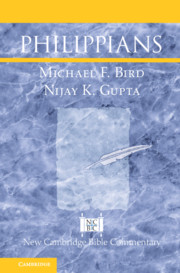Commentary
Published online by Cambridge University Press: 16 April 2020
Summary
Paul’s letter openings are not perfunctory and prosaic formalities nor necessary yet tedious niceties, rather, they are significant because they set the tone for the letter, hint at topics covered in the letter, and provide the initial texture for Paul’s message. Paul’s letter to the Philippians begins by following standard Hellenistic letter-writing conventions of sender, addressee, salutation, and thanksgiving, but with distinctive glosses (in Christ, grace and peace, God our Father, Lord Jesus Christ). Paul, as is his custom, uses his Greek name Paulos rather than his Hebrew name Sha’ul. Interesting too is that Paul, along with the letters to the other Macedonian churches in Thessalonica, does not call himself an “apostle.” This is most probably because, unlike the letters to the Galatians and the Corinthians, there was no need to accent his apostolic credentials in the face of any mounting dissent to his apostolic ministry or disparagement of his personality from the Macedonian assemblies. Paul nominates himself as lead author, hence the biographical “I” sections throughout, and other persons are referred to only in the third person. Even so, the letter is coauthored with or at least composed in cooperation with Timothy, much like several other Pauline letters (2 Cor 1:1; Col 1:1; Philm 1; cf. Paul, Timothy, and Silas in 1 Thess 1:1; 2 Thess 1:1). Timothy was Paul’s traveling companion from the city of Lystra in the province of Galatia.
Keywords
- Type
- Chapter
- Information
- Philippians , pp. 33 - 196Publisher: Cambridge University PressPrint publication year: 2020

